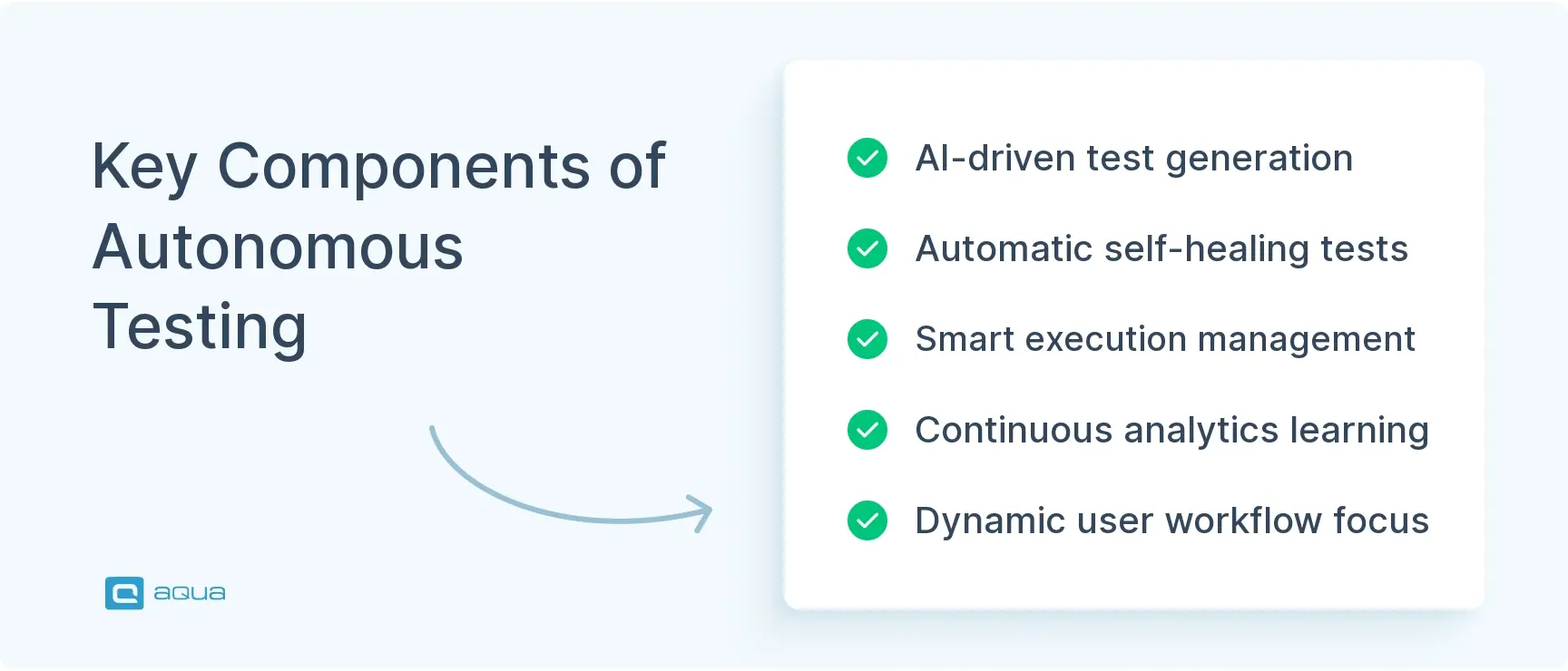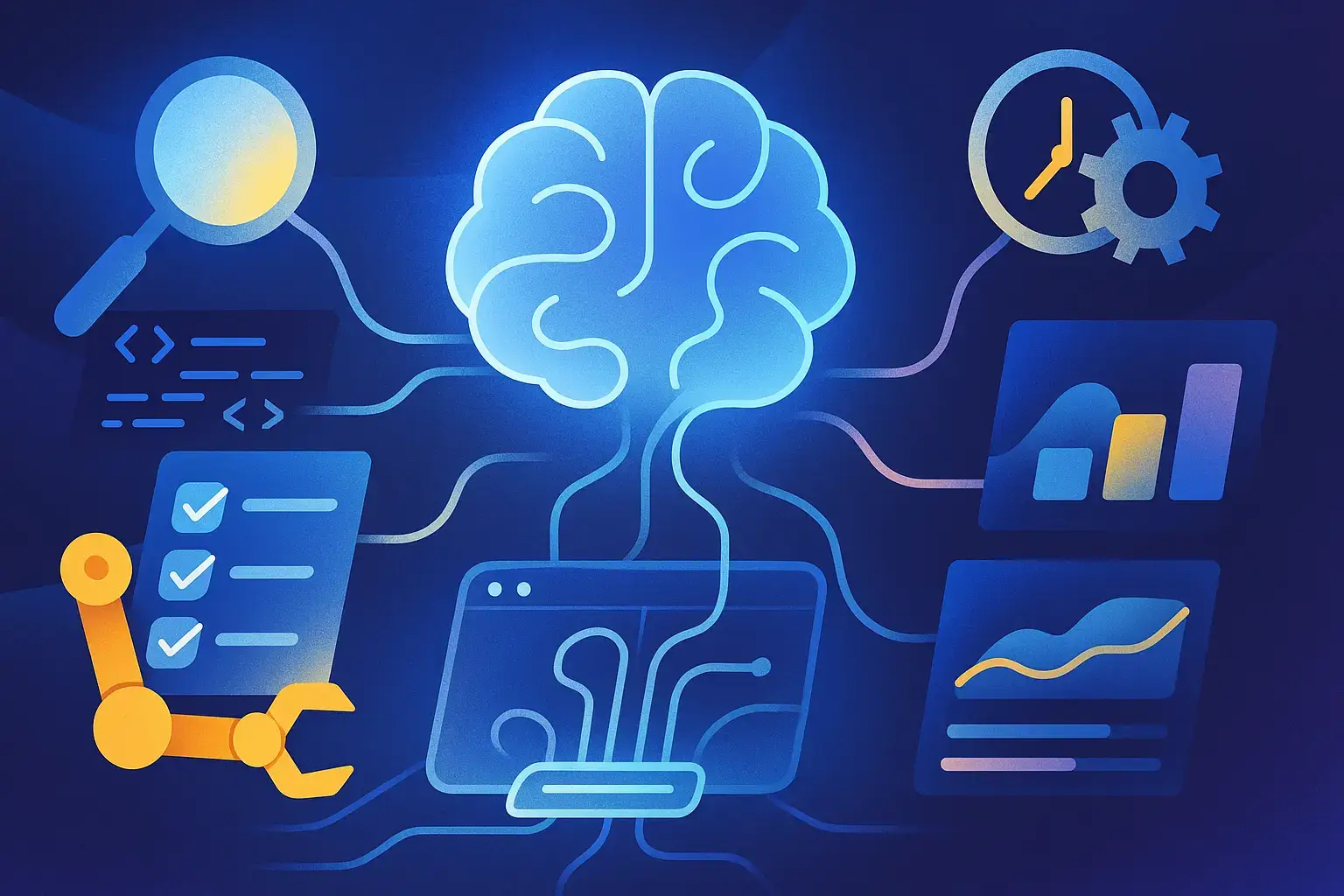- Autonomous testing uses AI to create, execute, and maintain tests with minimal human intervention, adapting to application changes without breaking.
- The system analyzes applications, generates test cases, self-executes them, and uses AI to identify actual defects with impressive accuracy.
- Autonomous testing platforms reduce test maintenance time dramatically, allowing QA teams to focus on exploratory testing rather than fixing broken scripts.
- Implementation requires patience, with most teams seeing reliable results after 4-6 weeks of teaching the system about application behavior.
- The technology works best when starting with stable application areas and integrating with existing CI/CD pipelines for continuous feedback.
While autonomous testing won’t magically solve all QA problems, it can significantly reduce maintenance time and expand test coverage. See how it compares to traditional approaches and whether it’s right for your team 👇
What is Autonomous Testing?
Here’s the main idea of autonomous testing: instead of you writing test scripts that break every time a developer changes something, the tool figures out what to test and how to test it. You point it at your application, tell it what’s important, and it handles the rest.Traditional automated testing is like providing someone with detailed, step-by-step instructions that break the moment anything changes. Autonomous testing uses AI to work more like hiring someone who can figure out what needs to be done without a manual. The AI learns your application’s behaviour, adapts when the interface changes, and focuses on whether functionality actually works rather than whether specific buttons are in exactly the right pixel location. Instead of you writing brittle test scripts that need constant maintenance, artificial intelligence handles the heavy lifting of test creation, execution, and updates. That comparison might sound abstract, so let’s get specific about how autonomous testing actually differs from the automation you’re probably already using.
Differences Between Autonomous & Automated Testing
| Aspect | Automated Testing | Autonomous Testing |
|---|---|---|
| Human Input | Requires significant manual effort for creation and maintenance | Minimal human intervention after initial setup |
| Intelligence | Follows pre-defined scripts and rules | Uses AI/ML to make decisions and adapt |
| Self-healing | Generally lacks self-healing capabilities | Can automatically fix broken tests |
| Learning | Doesn’t learn from previous runs | Continuously improves based on past results |
| Test Creation | Engineers write test scripts | System generates tests based on application analysis |
| Maintenance | Regular updates needed as application changes | Self-adjusts to application changes |
| Decision-making | No independent decision-making | Makes real-time decisions about what to test |
Where automated testing runs the scripts you’ve written, autonomous testing writes its own scripts based on how users actually interact with your application. It creates tests, runs them, and updates them when things change – without you having to maintain any test code.
How does Autonomous Testing Work
Most autonomous testing tools follow a similar pattern: they watch your application, learn how it behaves, and then create tests that focus on user workflows rather than specific UI elements. Let’s see the process in detail:
- Application Analysis: The system first studies your application, analysing its structure, user interfaces, and underlying code. Using AI algorithms, it identifies the critical components, workflows, and potential risk areas.
- Test Generation: Based on this analysis, the autonomous testing platform generates appropriate test cases. It is not random tests. It strategically designs scenarios that target high-risk areas and common user paths.
- Self-Execution: The system runs these tests independently, monitoring the application’s behaviour and responses in real-time.
- Result Analysis: AI algorithms analyse the test results, distinguishing between actual defects and false positives with impressive accuracy.
- Self-Healing: When the application changes (which we know happens all the time), the autonomous system doesn’t break down like traditional automation might. Instead, it identifies the changes and adjusts its testing approach accordingly.
- Continuous Learning: The system gets smarter with each test cycle. It learns from past results, identifies patterns, and refines its testing strategy for better efficiency and coverage.
AI engines can superpower these systems. They use techniques like computer vision to “see” the application interface, natural language processing to understand application context, and machine learning to improve their testing strategies continuously.
What makes this truly game-changing is that once the initial setup is complete, the system largely runs itself – freeing you to focus on more complex testing challenges or that backlog of unit tests you’ve been meaning to write.
Who Performs Autonomous Testing?
Autonomous testing changes how your entire team approaches quality assurance, not just the QA department. QA professionals shift from writing test scripts to defining testing strategy and teaching the system about business logic. Developers benefit because they’re not constantly fixing broken tests after UI changes. DevOps teams integrate these tools into CI/CD pipelines where they run continuously without manual intervention. You’ll need some AI/ML expertise to fine-tune how the system learns, and business analysts help define what normal user behaviour looks like. Even end users indirectly contribute through usage analytics that inform test scenarios.
The appeal for smaller teams is obvious: you can get comprehensive testing without deep automation expertise. But the most successful implementations still have experienced QA professionals guiding the overall strategy. Wouldn’t it be ideal to have a test management system that’s already embracing autonomous testing principles? aqua cloud is leading the integration of AI into testing processes, helping you shift from repetitive script writing to strategic quality planning. With aqua’s AI Copilot, you can generate comprehensive test cases from requirements in seconds – reducing test case creation time by up to 98%. The platform intelligently applies test design techniques like boundary value analysis and equivalence partitioning automatically, ensuring thorough coverage without manual effort. Integrations like Jira, Confluence, and Azure DevOps are the cherry on top to enhance your toolkit. And unlike traditional automation that breaks with every UI change, aqua’s approach keeps your testing assets relevant and maintainable. In a world where testing teams are being asked to do more with less, aqua cloud provides the intelligent foundation you need to evolve your testing approach.
Save 98% of time spent on test case creation with aqua's AI capabilities
When to Perform Autonomous Testing?
Knowing the right moment to deploy autonomous testing can make the difference between a successful implementation and a frustrating waste of resources. Here’s when you should consider bringing autonomous testing into your workflow:
During Continuous Integration
Autonomous testing shines in CI environments where code changes happen frequently. As developers push new code, the autonomous system can immediately test it, learning and adapting to the changes without manual intervention.
For Regression Testing
When you’re tired of maintaining massive regression test suites that break with every UI change, autonomous testing offers a breath of fresh air. It can handle large-scale regression testing while automatically adapting to application changes.
For Applications with Frequent Updates
If your product follows agile development with regular releases, autonomous testing keeps pace without the maintenance overhead of traditional automation.
When Testing Complex, AI-Driven Applications
There’s a beautiful symmetry in using AI to test AI. Autonomous testing is particularly effective for applications with dynamic content, machine learning components, or complex decision paths that would be difficult to test with conventional methods.
When Scaling Testing Efforts
If your testing team is overwhelmed or you’re trying to expand test coverage without adding headcount, autonomous testing helps you scale your testing capability efficiently.
When You Need 24/7 Testing
Autonomous systems can run continuous testing around the clock without human supervision, perfect for global teams or applications requiring constant monitoring.
Not Ideal For
- Brand new applications are still in conceptual phases
- Applications with extremely strict regulatory requirements where test processes must be explicitly documented
- Simple applications where the overhead of setting up autonomous testing outweighs the benefits
The best time to consider autonomous testing is when your team feels the pain of maintaining automated tests or when you’re drowning in regression testing while trying to keep up with rapid development cycles.
Key Components of Autonomous Testing
Understanding what makes autonomous testing work helps you evaluate different tools and set realistic expectations for implementation.
Test Generation
The core engine analyses your application structure and creates tests based on user workflows rather than UI elements. It uses machine learning to identify high-risk areas and generates realistic test data that mirrors actual user behaviour.
Self-Healing
This is what separates autonomous testing from traditional automation. When developers change a button ID or move a form field, the system adapts automatically instead of breaking:
- Dynamic element recognition that works regardless of selector changes
- Alternative path discovery when workflows are modified
- Automatic failure analysis to distinguish real bugs from test maintenance issues
Execution Management
The system decides what to test, when to test it, and how to optimise test runs for speed and coverage. It prioritises tests based on recent code changes and runs them in parallel to minimise feedback time.
Analytics and Learning
Real-time dashboards show results, but more importantly, the system learns from each test run. It identifies patterns in failures, predicts problem areas based on code changes, and continuously refines its testing strategy.
These components work together to create a testing system that evolves with your application, but the quality of implementation varies significantly between tools.

Benefits of Autonomous Testing
If you’re wondering whether autonomous testing is worth the investment, here’s what you can realistically expect. We list the benefits of autonomous testing, one by one.
Your time gets freed up for actual testing
Instead of spending half your day fixing broken Selenium scripts because someone changed a CSS class, you focus on exploratory testing and complex scenarios that actually need human judgment. Most teams see their test maintenance time drop dramatically once the system learns their application.
You catch bugs you’ve missed
Autonomous tools test combinations and edge cases you’d never think to script manually.They’re particularly good at finding issues that happen when users navigate through your app in unexpected ways – the kind of bugs that slip through your carefully planned test cases.
You can finally test everything
Remember that backlog of features you never got around to testing because you were too busy maintaining existing tests?Autonomous testing can cover those areas without you writing and maintaining scripts for every possible scenario.
The catch is that these benefits take time to materialise.The system needs to learn your application first, and you’ll spend the early weeks teaching it what normal behaviour looks like.
Quality Improvements That Drive Business Value
- More stable releases with fewer customer-reported issues
- Ability to test complex scenarios previously considered too difficult to automate
- Consistent testing approach regardless of team size or experience
The most dramatic benefit may be the shift in how your team spends their time – moving from repetitive execution of test cases to focusing on exploratory testing, improving test strategies, and addressing more complex quality challenges.
Autonomous Testing Tools
As demand for autonomous software testing grows, a variety of autonomous testing tools have entered the market to help organisations implement these advanced testing approaches. These tools leverage AI and machine learning to create, execute, and maintain tests with minimal human intervention.
Popular autonomous testing tools
- Mabl – Cloud-based platform with intelligent test maintenance and visual testing capabilities.
- Functionize – Uses machine learning for test generation, self-healing, and large-scale execution.
- ACCELQ – Codeless test automation with AI test design and autonomous execution.
- Applitools Ultrafast Grid – Primarily for visual AI testing with self-maintaining test capabilities.
These platforms can analyse application behaviour, identify critical testing paths, and automatically adjust when applications change.
Key features to look for
The best autonomous testing tools:
- Integrate seamlessly with existing CI/CD pipelines
- Provide comprehensive reporting
- Improve over time as they learn from testing results
When evaluating autonomous testing tools, consider:
- Ease of implementation
- Learning curve
- Integration capabilities
- The specific testing challenges they address.
Stages of implementing Autonomous Testing
Don’t expect to flip a switch and have autonomous testing running perfectly.It’s more like training a new team member who happens to be really good at learning patterns.
Start with evaluation
Pick a stable part of your application; ideally, something with clear user workflows like login or checkout.Avoid areas that change frequently while the system is learning.
Set up and integrate
Install the tool, connect it to your CI/CD pipeline, and configure it to access your application.This usually takes a few days to get right, especially if you have complex authentication or staging environments.
Teach the system
You’ll spend the first few weeks showing the tool what normal behaviour looks like and correcting its mistakes. Think of this as a training period where you’re actively involved in reviewing and approving test results.
Let it learn gradually
Start with supervised mode, where you review everything the system does. As it gets better at understanding your application, you can give it more autonomy. Most teams see reliable results after 4–6 weeks of this process.
Expand coverage slowly
Once the system handles your initial test area well, gradually add more features and workflows. Don’t try to automate your entire application at once. That’s a recipe for chaos.
The key is patience. Autonomous testing isn’t plug-and-play, but once it learns your application, it can handle testing tasks that would take you weeks to script manually.
Challenges in implementing Autonomous Testing
Before you get too excited about autonomous testing, here are the problems you’ll likely encounter and how to handle them.
Your application might be too complex
If you’re using custom UI frameworks or have unusual interaction patterns, the AI might struggle to understand what’s happening.Start with standard web apps before tackling exotic interfaces.
Your team might resist the change
QA engineers often worry about being replaced, developers don’t want to change their workflows, and managers question the upfront costs.The solution is starting small and demonstrating wins rather than promising transformation.
The licensing costs can be shocking
Commercial autonomous testing tools often charge enterprise prices.Look for consumption-based pricing or consider hybrid approaches that mix traditional automation with autonomous features.
AI has limits
Current tools struggle with complex visual verification, need lots of training data, and get confused when you radically change features.Keep human testers involved for anything the AI can’t handle reliably.
Data privacy becomes complicated
The AI needs access to your application data to learn, which can be problematic for regulated industries.You might need on-premises solutions or extensive data anonymisation.
The good news is that none of these problems are deal-breakers.They just require realistic planning and expectations instead of believing the marketing hype.
Best Practices for Implementing Autonomous Testing
If you decide to move forward with autonomous testing, here’s how to avoid the common mistakes that derail implementations.
Start with one application area
Pick something that rarely changes: your login flow, checkout process, or user registration. Let the system get good at something stable before throwing complex scenarios at it.
Define what success looks like
Whether it’s 50% less time spent on test maintenance or catching bugs that your current automation misses, set clear goals. Without measurable objectives, you’ll struggle to know if it’s working.
Make sure your team understands the technology
The biggest failure point is teams that expect autonomous testing to work like traditional automation. Invest in training so people know what to expect.
Keep experienced testers involved
Autonomous doesn’t mean completely hands-off, especially in the first few months.Someone needs to review results and guide the system when it gets confused.
Connect it to your CI/CD pipeline
Autonomous testing only delivers value if it runs automatically with your builds.Don’t treat it as a separate manual process.
Most importantly, celebrate the early wins and share them with your broader organisation.Autonomous testing often faces scepticism, so demonstrating concrete benefits helps build support for the long-term investment.
Manual vs. Automated vs. Autonomous Testing
To understand where autonomous testing fits in your overall strategy, it helps to see how it stacks up against the approaches you’re already using.
| Aspect | Manual Testing | Automated Testing | Autonomous Testing |
|---|---|---|---|
| Human Involvement | High (entire process) | Medium (creation and maintenance) | Low (oversight only) |
| Test Creation | Written by testers | Coded by automation engineers | Generated by AI |
| Speed | Slow | Fast | Very fast |
| Scalability | Poor | Good | Excellent |
| Adaptability to Changes | High (humans adapt easily) | Low (scripts break with changes) | High (self-healing capability) |
| Initial Setup Time | Low | High | Medium to high |
| Maintenance Effort | N/A | High | Low |
| Cost Efficiency | High cost for ongoing testing | Medium to high cost overall | High initial cost, low ongoing cost |
| Test Coverage | Limited by human capacity | Limited by what’s explicitly coded | Comprehensive (can discover test paths) |
| Intelligence | Human intelligence | No intelligence (follows scripts) | Artificial intelligence |
| Best For | Exploratory testing, UX evaluation | Repetitive tests, regression | Complex applications, continuous testing |
| Learning Capability | Humans learn continuously | None | Improves over time via machine learning |
| Decision Making | Intuitive human decisions | No decisions (pass/fail only) | Data-driven decisions based on patterns |
The key insight from this comparison is that you don’t need to choose just one approach. Most successful testing strategies combine all three – manual testing for exploratory work and user experience validation, automated testing for stable regression scenarios, and autonomous testing for comprehensive coverage of complex workflows. The trick is knowing which tool to use when.
As autonomous testing reshapes QA, choosing the right platform to support this evolution becomes critical. aqua cloud stands out as a comprehensive test management solution designed for this new era, combining AI-powered test case generation with complete traceability between requirements, tests, and results. With aqua, you gain a central hub for both manual and automated tests, integrating with over 10 automation tools while maintaining banking-grade traceability for compliance needs. The AI Copilot doesn’t just create tests, it generates test data, improves documentation, and provides real-time guidance through its chat interface. Teams using aqua report saving up to 90% of their time on recurring tasks through reusable test cases and intelligent automation. Why struggle with the maintenance burden of traditional automation or the limitations of manual testing when you can leverage the power of AI to transform your testing process?
Transform your QA process with 100% traceable, AI-powered test management
Autonomous Testing in Agile Environments
If you’re working in two-week sprints with daily builds, autonomous testing can keep up with your pace better than traditional automation. The self-healing capability means you’re not spending sprint time fixing broken tests because someone renamed a CSS class. The biggest advantage for agile teams is the rapid feedback. Autonomous testing can start evaluating work-in-progress features based on expected behaviour patterns, giving developers immediate feedback without waiting for formal test creation. For shift-left testing, autonomous systems can identify high-risk areas during sprint planning and provide quality insights during retrospectives – all without adding overhead to your existing agile processes.
Autonomous Testing Ethical Considerations
Beyond the technical challenges, autonomous testing creates some organisational and practical concerns that can catch teams off guard. These are worth thinking through before you start implementation.
Responsibility and Accountability
When an autonomous system misses a critical bug, who bears responsibility? Unlike manual or traditional automated testing, where accountability is clear, autonomous systems blur these lines. Teams need clear policies about who’s responsible for verifying critical functionality and how to handle situations where autonomous testing falls short.
Transparency in Decision Making
Autonomous systems make complex decisions about what to test and how to interpret results. These “black box” decisions can create challenges when explaining testing coverage or justifying test strategies to stakeholders or regulators.
To address this, look for autonomous testing platforms that provide explainable AI: systems that can articulate why they made specific testing decisions in human-understandable terms.
Data Privacy in Training
Autonomous systems learn from your application data, potentially raising privacy concerns, especially when testing systems that handle sensitive information. Implement proper data anonymisation and ensure your autonomous testing vendor has strong data handling policies.
Impact on Testing Careers
While autonomous testing doesn’t eliminate the need for human testers, it does change the skill set required. Companies have an ethical responsibility to provide learning and growth opportunities for testers as their roles evolve.
Algorithmic Bias
The AI powering autonomous testing may develop biases based on its training data. For example, it might test certain workflows more thoroughly than others based on patterns it observed during training. Regular audits of testing patterns can help identify and correct these biases.
Over-reliance Risks
Developing an over-reliance on autonomous systems without appropriate human oversight can create blind spots in your testing approach. Maintain a healthy scepticism and periodically validate that your autonomous system is delivering the coverage you expect.
Address these ethical considerations, and you can implement autonomous testing in ways that enhance your testing capability while maintaining high ethical standards.
Future Trends in Autonomous Testing
Autonomous testing tools are improving quickly, but don’t expect magic. The most realistic near-term improvements are better handling of complex applications and more intuitive configuration, making the current technology work more reliably rather than revolutionary breakthroughs. Here’s what to watch for:
Predictive Testing
Future autonomous testing systems will move beyond reactive testing to predictive approaches. By analysing code changes and historical data, these systems will anticipate where bugs are likely to occur and focus testing efforts accordingly. This shift from “finding bugs” to “preventing bugs” will be a big change in testing philosophy.
Natural Language Interfaces
Expect to see autonomous testing platforms that accept test requirements in plain English. Rather than configuring systems through complex interfaces, testers will describe what they want tested, and the AI will handle the implementation details. This democratises testing by making it accessible to non-technical stakeholders.
Cross-platform Intelligence
As applications spread across devices and platforms, autonomous testing will develop a unified understanding of application behaviour regardless of environment. A single autonomous system will be able to test web, mobile, desktop, and IoT implementations of an application while understanding their relationships.
Integration with Development AI
Autonomous testing will collaborate with AI-assisted development tools, creating a seamless flow where code is written and tested by complementary AI systems. This symbiotic relationship will catch potential issues before code is even committed.
Sentiment Analysis in Testing
Beyond functional testing, autonomous systems will begin evaluating user experience factors by analysing sentiment in user feedback and correlating it with application behaviour. This bridges the gap between functional correctness and user satisfaction.
Quantum Computing Impact
As quantum computing matures, it will enable autonomous testing to model complex systems and user behaviors at unprecedented scale, allowing for more sophisticated test scenarios than currently possible.
Role of Human Testers in the Era of Autonomous Testing
Human testers aren’t becoming obsolete. They’re evolving into strategic quality partners. The future tester will:
- Function as an “AI trainer,” teaching autonomous systems about business context and expected behaviours
- Focus on exploratory testing to find issues that automated systems might miss
- Analyse patterns in autonomous testing results to identify larger quality trends
- Collaborate with developers on fixing complex issues identified by autonomous systems
- Design testing strategies that combine human insight with AI execution
- Serve as the final authority on acceptance criteria and user experience
The most successful testing professionals will be those who embrace autonomous testing as a powerful tool in their arsenal rather than viewing it as a replacement for their skills.
Conclusion
Autonomous testing won’t magically solve all your QA problems, but it can significantly reduce the time you spend maintaining broken test scripts. The technology works best when you start small with stable application areas, set realistic expectations about the learning curve, and keep experienced testers involved to guide the system. While the upfront investment in tools and training can be substantial, implementing autonomous testing thoughtfully will help you finally focus on exploratory testing and complex scenarios instead of fixing selectors every sprint. The future of testing is about using automation to handle the repetitive maintenance work so you can spend your time on testing that actually requires human insight.


















